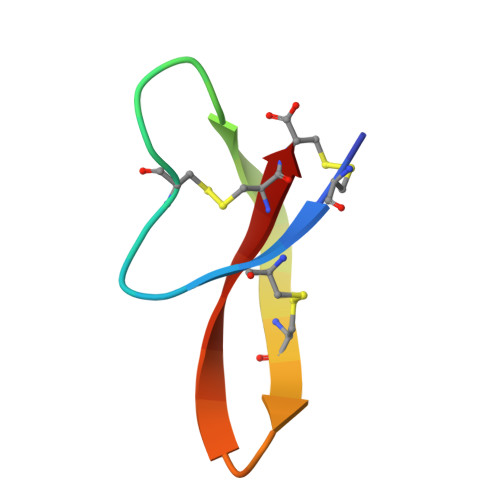Toward understanding the cationicity of defensins. Arg and Lys versus their noncoded analogs.
Zou, G., de Leeuw, E., Li, C., Pazgier, M., Li, C., Zeng, P., Lu, W.Y., Lubkowski, J., Lu, W.(2007) J Biological Chem 282: 19653-19665
- PubMed: 17452329
- DOI: https://doi.org/10.1074/jbc.M611003200
- Primary Citation of Related Structures:
2PLZ, 2PM4 - PubMed Abstract:
Human defensins are a family of small antimicrobial proteins found predominantly in leukocytes and epithelial cells that play important roles in the innate and adaptive immune defense against microbial infection. The most distinct molecular feature of defensins is cationicity, manifested by abundant Arg and/or Lys residues in their sequences. Sequence analysis indicates that Arg is strongly selected over Lys in alpha-defensins but not in beta-defensins. To understand this Arg/Lys disparity in defensins, we chemically synthesized human alpha-defensin 1 (HNP1) and several HNP1 analogs where three Arg residues were replaced by each of the following six alpha-amino acids: Lys, ornithine (Orn), diaminobutyric acid (Dab), diaminopropionic acid (Dap), N,N-dimethyl-Lys ((diMe)Lys), and homo-Arg ((homo)Arg). In addition, we prepared human beta-defensin 1 (hBD1) and (Lys-->Arg)hBD1 in which all four Lys residues were substituted for Arg. Bactericidal activity assays revealed the following. 1) Arg-containing HNP1 and (Lys-->Arg)hBD1 are functionally better than Lys-HNP1 and hBD1, respectively; the difference between Arg and Lys is more evident in the alpha-defensin than in the beta-defensin and is more evident at low salt concentrations than at high salt concentrations. 2) For HNP1, the Arg/Lys disparity is much more pronounced with Staphylococcus aureus than with Escherichia coli, and the Arg-rich HNP1 kills bacteria faster than its Lys-rich analog. 3) Arg and Lys appear to have optimal chain lengths for bacterial killing as shortening Lys or lengthening Arg in HNP1 invariably becomes functionally deleterious. Our findings provide insights into the Arg/Lys disparity in defensins, and shed light on the cationicity of defensins with respect to their antimicrobial activity and specificity.
- Institute of Human Virology, University of Maryland Biotechnology Institute, Baltimore, Maryland 21201, USA.
Organizational Affiliation:
















